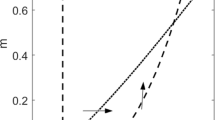Abstract
Modeling of coevolution of nodular bacteria and legume plants allowed us to propose a mathematical criterion (index) of functional integrity of symbiosis (FIS), which is based on analysis of genotype frequency covariation matrices with fluctuating system parameters. We found FIS to be positively correlated with the ecological efficiency of symbiosis (its impact on seed productivity of plants) and negatively correlated with the diversity indices of partners. These dependences allow us to explain the increase in the structural-functional integrity of symbiosis, which is characteristic for its macroevolution, by natural selection of the increase of interaction efficiency of partners.
Similar content being viewed by others
References
Vorob’ev, N.I. and Provorov, N.A., Modeling the Evolution of Legume-Rhizobial Symbiosis with Bacteria Multishtammovoy Competition for the Inoculation of Symbiotic Niches, Ekol. Genet., 2008, vol.6, no. 4, pp. 3–11.
Vorobyeva, E.I., Problem of Organism Integrity and Its Perspectives, Biol. Bull., 2006, vol.31, no. 5, pp. 427–436.
Gorban’, A.N, Manchuk, V.T., and Petushkova, E.V., Dynamics of Correlations between Physiological Parameters during Adaptation and Ecological-Evolutionary Principle of Multifactoriality, in Problemy ekologicheskogo monitoringa i modelirovaniya ekosistem (Problems of Ecological Monitoring and Modeling of Ecosystems), Leningrad: Gidrometeoizdat, 1987, vol.10, pp. 187–198.
D’yakov, Yu.T., Ozeretskovskaya, O.L., Dzhavakhiya, V.G., and Bagirova, S.F., Obshchaya i molekulyarnaya fitopatologiya (General and Molecular Phytopathology), Moscow: Obshch. Fitopatol., 2001.
Kulaichev, A.P., Metody i sredstva kompleksnogo analiza dannykh (Methods and Tools for Complex Data Analysis), Moscow: FORUM-INFRA-M, 2006.
Provorov, N.A., Genetic and Evolutionary Basis of the Teaching about Symbiosis, Zh. Obshch. Biol., 2001, vol.62, no. 6, pp. 472–495.
Provorov, N.A., Borisov, A.Yu., and Tikhonovich, I.A., Comparative Genetics and Evolutionary Morphology of Symbiosis Formed by Plants with Nitrogen-Fixing Microbes and Endomycorrhizal Fungi, Zh. Obshch. Biol., 2002, vol.63, no. 6, pp. 451–472.
Provorov, N.A. and Vorob’ev, N.I., Simulation of Bacteria-Plant Coevolution in the Mutualistic Symbiosis, Russ. J. Genet., 2009, vol.45, no. 5, pp. 581–594.
Rostova, N.S. and Brutch, N.B., Genotypic and Environmental Correlations of Some Traits of Flax, Tr. Prikl. Bot. Genet. Sel., 1989, vol.125, pp. 56–64.
Severtsov, A.N., Glavnye napravleniya evolyutsionnogo protsessa (The Main Directions of the Evolutionary Process), Moscow: Mosk. Gos. Univ., 1967.
Tikhonovich, I.A. and Provorov, N.A., Symbiogenetics of Plant-Microbe Interactions, Ekol. Genet., 2003, vol.1, pp. 36–46.
Tikhonovich, I.A. and Provorov, N.A., Simbiozy rastenii i mikroorganizmov: molekulyarnaya genetika agrosistem budushchego (Symbiosis of Plants and Microorganisms: Molecular Genetics of Agricultural Systems of the Future), St. Petersburg: St.-Peterb. Gos. Univ., 2009.
Schmalhausen, I.I., Puti i zakonomernosti evolyutsionnogo protsessa (Pathways and Patterns of the Evolutionary Process), Moscow: Nauka, 1983.
Yablokov, A.V. and Yusufov, A.G., Evolyutsionnoe uchenie (Evolutionary Theory), Moscow: Vysshaya Shkola, 2004.
Douglas, A.E., Host Benefit and the Evolution of Specialization in Symbiosis, Heredity, 1998, vol.81, no. 6, pp. 599–603.
Frank, S.A., Genetics of Mutualism: the Evolution of Altruism between Species, J. Theor. Biol., 1994, vol.170, pp. 393–400.
Hansen, T.F. and Martins, E.P., Translating between Microevolutionary Processes and Macroevolutionary Patterns: The Correlation Structure of Inter-Specific Data, Evolution, 1996, vol.50, pp. 1404–1417.
Lammerts van Bueren, E.T., Struik, P.C., Tiemens-Hulscher, M., and Jacobsen, E., Concepts of Intrinsic Value and Integrity of Plants on Organic Plant Breeding and Propagation, Crop. Sci., 2003, vol.43, pp. 1922–1929.
Lewis, D.H., Microorganisms and Plants: The Evolution of Parasitism and Mutualism, in Evolution of Microbial World, Cambridge: Cambridge Univ. Press, 1974, pp. 367–392.
Nei, M., Estimation of Average Heterozygosity and Genetic Distance from a Small Number of Individuals, Genetics, 1978, vol.89, pp. 583–590.
Provorov, N.A., Saimnazarov, U.B., Bahromov, I.U., Pulatova, D.Z., Kozhemyakov, A.P., and Kurbanov, G.A., Effect of Rhizobia Inoculation on the Seed (Herbage) Production of Mungbean (Phaseolus aureus Roxb.) Grown at Uzbekistan, J. Arid. Environ., 1998, vol.39, pp. 569–575.
Provorov, N.A. and Vorobyov, N.I., Equilibrium between the “Genuine Mutualists” and “Symbiotic Cheaters” in the Bacterial Population Co-Evolving with Plants in a Facultative Symbiosis, Theor. Population Biol., 2008, vol.74, no. 4, pp. 345–355.
Provorov, N.A. and Vorobyov, N.I., Host Plant as on Organizer of Microbial Evolution in the Beneficial Symbioses, Phytochem. Rev., 2009, vol.8, pp. 519–534.
Sprent, J.I., Evolving Ideas of Legume Evolution and Diversity: A Taxonomic Perspective on the Occurrence of Nodulation, New Phytol., 2007, vol.174, pp. 11–25.
Tikhonovich, I.A. and Provorov, N.A., From Plant-Microbe Interactions to Symbiogenetics: a Universal Paradigm for the Inter-Species Genetic Integration, Ann. Appl. Biol., 2009, vol.154, no. 3, pp. 341–350.
Author information
Authors and Affiliations
Additional information
Original Russian Text © N.I. Vorobiev, N.A. Provorov, 2010, published in Ekologicheskaya Genetika, 2010, Vol. 8, No. 3, pp. 17–26.
Rights and permissions
About this article
Cite this article
Vorobiev, N.I., Provorov, N.A. Modeling of the evolution of legume-rhizobia symbiosis towards improved functional integrity of partners and ecological efficiency of their interactions. Russ J Genet Appl Res 1, 448–457 (2011). https://doi.org/10.1134/S2079059711050169
Received:
Accepted:
Published:
Issue Date:
DOI: https://doi.org/10.1134/S2079059711050169




